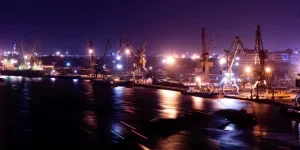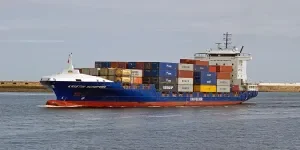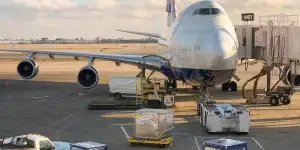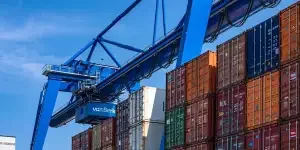Just a few years ago, the idea of self-sailing ships operating without a crew was nothing more than a fantasy. However, these fantasies become reality in the spring of 2022 with the operation of Yara Birkeland, the world’s first fully electric and autonomous container ship, which operates without crew onboard for specific operations.
So, what exactly are autonomous ships, also known as maritime autonomous surface ships (MASS)? And what would be the implications of their application in international freight shipping? After all, a lot of global trade — in fact, almost 80% of it— happens over the sea. Continue reading to find out the answers as we explore the short- and long-term outlook of autonomous shipping!
Table of Contents
1. What is an autonomous ship?
2. Short-term developments in autonomous shipping
3. Long-term predictions for autonomous shipping
4. Autonomous ships will streamline ocean freight shipping
What is an autonomous ship?
An autonomous ship, as the name suggests, is a self-driving vessel capable of sailing and maneuvering on its own without the need for direct human operation. Instead of having crew members on board, these ships use advanced technologies such as artificial intelligence (AI), sophisticated sensors, and monitoring algorithms.
These autonomous vessels operate and make important decisions, including steering, speeding up or slowing down, and avoiding collisions with other vessels or obstacles. The degree of autonomy can vary, and there are generally three levels:
- Remotely-controlled: This type of autonomous ship is operated from a different location, similar to piloting a drone with a remote control. However, human crew members remain on board to perform various tasks and intervene if necessary.
- Semi-autonomous: This kind of autonomous ship has automated processes and decision support. They might be able to steer and move at a constant speed, but they might need a person to take control of navigation in busy areas, for example.
- Fully autonomous: A fully autonomous ship is completely operated by artificial intelligence systems and onboard machinery without any human intervention at all. It’s as if the ship is its own captain.
Short-term developments in autonomous shipping
The rapid advancements in automated navigation systems, AI and machine learning, and high-speed satellite communications have indeed enabled the advent of maritime autonomous surface ships. However, these technologies have yet to reach the necessary maturity for application in large freight ships within international shipping and logistics.
The following are some of the near-term developments we might see in autonomous shipping in the next 3-5 years before we witness large freight ships autonomously transporting goods across the sea:
Remote control will be the first step
Given that autonomous technologies are still largely in experimental stages and the high costs associated with integrating such technologies into existing maritime infrastructure, the shift to autonomous freight shipping will likely be a gradual process. Companies in the shipping industry are expected to first adopt remote-controlled vessels.
The hybrid operation mode of remote-controlled ships combines the efficiency of automation with the adaptability and safety of having humans on board. This gradual transition, besides being economically viable, will facilitate real-world testing of autonomous navigation systems, sensors, and software, which will eventually lead to greater autonomy.
More pilot projects and testing
As governments around the world recognize the benefits of autonomous shipping technologies, they are heavily investing in research and development to accommodate autonomous vessels in international waters.
For instance, the Chinese government has recently established a 300-square-mile autonomous shipping testbed in Guangdong. This move is not surprising, considering China reportedly holds about 96% of the registered patents related to the development of autonomous vessel technology.
Moreover, leading tech and software companies will continue their collaboration with shipbuilding and engine manufacturers to conduct autonomous shipping trials. “Zhi Fei,” translating to “Flying Wisdom,” is an exemplary pioneering project in China’s advancement toward autonomous maritime shipping.
This autonomous container ship, measuring 120 meters in length and using an electric propulsion system, has a capacity of 300 Twenty-foot Equivalent Units (TEUs) and is capable of transporting cargo containers between ports along the Chinese coast.
Developing and updating the regulatory framework
The current regulatory framework presents significant challenges to the growth and adoption of autonomous shipping. The existing regulations and guidelines are closely designed around manned operations.
For example, the STCW Code A, Section VIII/2, paragraph 8.4, emphasizes that officers in charge of watch duties “shall maintain a proper watch, making the most effective use of all resources available.” This implies the presence and duties of human watchkeepers and officers onboard.
The International Maritime Organization (IMO) acknowledges these regulatory challenges. During its 103rd session in May 2021, the Maritime Safety Committee (MSC), a key committee within the IMO, undertook a thorough regulatory scoping exercise targeting maritime autonomous surface ships (MASS).
The MSC is committed to further advancing the development of a goal-based instrument aimed at regulating the operation of MASS. National governments are also actively engaged in shaping the regulatory landscape to safely integrate autonomous vessels into their maritime industry. For instance, the European Commission has developed the first version of EU Operational Guidelines on trials of MASS.
Enhancing the existing maritime infrastructure
The current maritime infrastructure has been built and adapted over years, if not centuries, to accommodate manned vessels. Ports and their facilities are built to anticipate human interaction and oversight. For instance, many ports rely on human pilots and tugboats to assist cargo ships in docking.
Parallel to the development of autonomous technologies, the upcoming years are anticipated to attract investment in port infrastructure enhancements. Terminals are expected to be modernized to enable direct communication with the ships’ cargo systems, facilitating coordination of the automated loading and unloading procedures.
In addition, Vessel Traffic Services (VTS) will adopt advanced algorithms and artificial intelligence to streamline route planning and the traffic management of both autonomous and crewed vessels. This will allow the accurate prediction of autonomous vessel movements based on present position, speed, and heading data.
Since autonomous cargo ships depend greatly on integrated technologies for navigation, communication, and system control, they are potentially vulnerable to cyber threats. As a response to this, maritime cybersecurity will be enhanced with robust encryption protocols designed to safeguard data in transit from both interception and unauthorized access.
Long-term predictions for autonomous shipping
We have explored a range of short-term future developments so far, which are anticipated to make the widespread deployment of autonomous freight ships feasible in the coming decade. According to a market analysis report by Mordor Intelligence, the market size for autonomous ships is projected to reach USD 11.93 billion by 2029.
The following are some long-term forecasts for autonomous shipping and the implications these might have for freight shipping and logistics:
Global fleet will become fully autonomous
As off-site ship operations become increasingly feasible through remote-controlled vessels in the next few years, regulators and shipping companies are expected to gain confidence in autonomous technologies. Such a shift will lead the shipping industry to adopt semi-autonomous ships progressively.
With the development and integration of sensor fusion technology and advanced satellite communication, it’s projected that within the next two decades, fully autonomous ships will largely replace traditional vessels, making international shipping predominantly AI-driven.
This shift will lead to a significant decline in demand for traditional seafaring roles, such as ship officers, deckhands, and maintenance crews, as the workforce transitions from onboard tasks to shore-based roles.
Simultaneously, the rise of autonomous operations will drive the need for new roles requiring specialists in autonomous vehicles and cutting-edge technologies to manage, maintain, and troubleshoot the complex systems involved in autonomous shipping.
Substantial reduction in maritime operational costs
In a fully autonomous shipping industry, cargo ships will be equipped with innovative propulsion and power systems. Such systems will rely on eco-friendly and renewable energy, helping minimize maritime emissions to nearly zero. Concurrently, AI-powered maintenance systems will be capable of analyzing data from sensors in real-time.
These autonomous algorithms can forecast when systems might fail or determine when parts may need replacement — all without any crew members on board. Thanks to these advances, shipping companies could see their overall costs drop by an estimated 20%.
Even in fuel-driven autonomous ships, navigation systems can be programmed to consistently operate at optimum speeds, resulting in less fuel waste. Additionally, autonomous ships can optimize routes based on weather, sea conditions, and other factors, proactively adjusting both planned routes and speeds for maximum fuel efficiency.
In a study examining the operational and economic advantages of autonomous shipping, it has been estimated that, for each autonomous ship, savings on fuel costs and crew expenditures could amount to up to USD 4.3 million over its 25-year lifecycle.
Enhanced maritime safety and reduced human error
Human error is believed to be a factor in approximately 80% to 90% of marine accidents. Crew members, after all, are susceptible to a range of factors, such as fatigue and overwork, poor decision-making, and miscommunication.
In contrast, autonomous ships are equipped with advanced sensory and situational awareness systems that enable the precise detection of nearby objects, shorelines, and other vessels. AI algorithms can determine the safest and most efficient navigational paths, allowing for the automatic adjustment of the ship’s course to avoid any detected hazards.
Moreover, autonomous ships employ automated systems to manage propulsion, steering, and other vital operations. Such systems operate with precision and consistency, which reduces the likelihood of human error in manual controls, including inaccurate speed adjustments or navigational maneuvers. In the next 20 years, the maritime industry could reach a point where collisions and grounding incidents are virtually eliminated.
Innovative ship designs unrestricted by crew requirements
Without the need to accommodate crew in autonomous ships, spaces traditionally reserved for living quarters, kitchen facilities, and other life-supporting infrastructure can be reconfigured to increase cargo capacity or optimize the equipment layout for better efficiency.
This could lead to futuristic designs that are sleeker and more streamlined, reducing drag and fuel consumption. For example, cargo carriers could be fully submersible and travel completely underwater, taking advantage of more stable conditions and avoiding surface-level hazards.
Alternatively, cargo ships could be designed to transform and adapt their structure in response to the needs of the cargo. For instance, a segmented design could enable parts of the ship to detach and dock independently, optimizing space utilization and improving the efficiency of loading and unloading processes.
Autonomous ships will streamline ocean freight shipping
Autonomous ships are set to revolutionize ocean freight and global trade. With these advancements, we can expect shorter transit times, reduced fuel consumption, and a significant decrease in human-error navigational accidents.
Moreover, autonomous ships could potentially access regions too dangerous or less economical for conventional, human-crewed ships. For example, ice-class autonomous vessels could navigate through Arctic routes that are typically inaccessible for most of the year, opening new trade paths.
Interested in learning more about how automation can be applied to supply chain operations beyond shipping? Check out this blog post to discover how generative AI can automate the entire process of customs brokerage!

Looking for a logistics solution with competitive pricing, full visibility, and readily accessible customer support? Check out the Alibaba.com Logistics Marketplace today.




